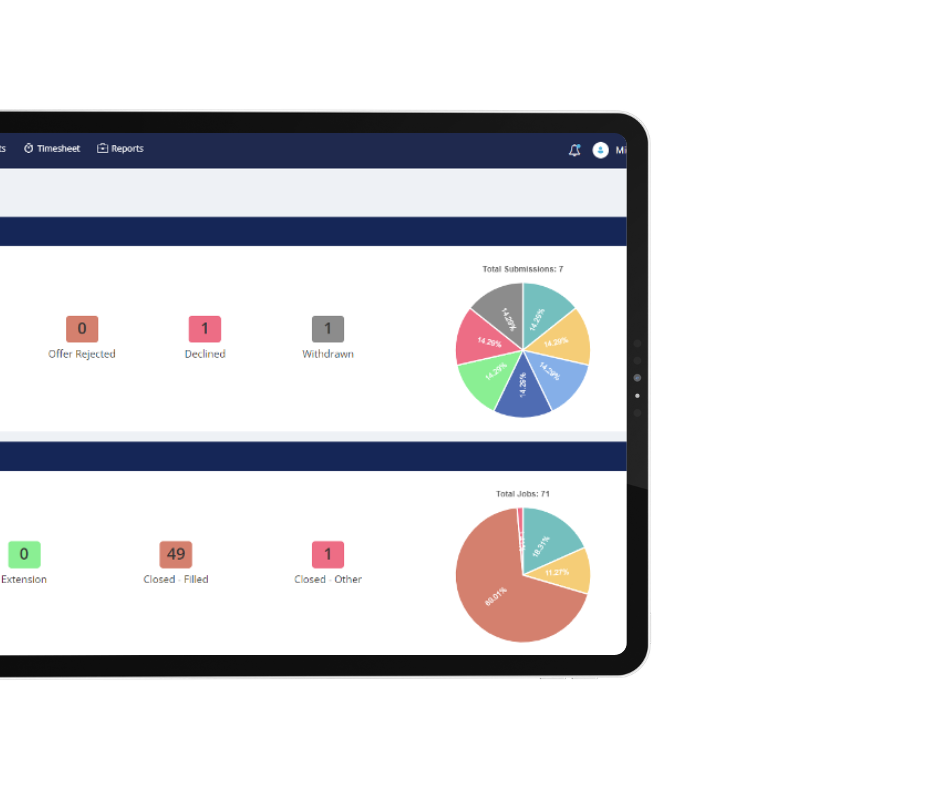Published: December 5, 2023
The delicate balance of staffing within healthcare organizations is a critical factor that profoundly influences the quality of patient care and the overall efficiency of the healthcare system. Understaffing can lead to detrimental consequences, such as compromised patient care and increased wait times, while overstaffing can strain financial resources and hinder productivity. The fill rate, representing the percentage of filled positions with qualified staff, emerges as a key metric in addressing these challenges.
This blog post delves into the profound impacts of both understaffing and overstaffing in healthcare facilities, emphasizing the importance of maintaining an optimal fill rate. Additionally, it introduces NexusVMS, a revolutionary vendor management system by LaborEdge, designed to tackle the complexities of healthcare staffing.
Through a comprehensive exploration of NexusVMS' features and real-world success stories, this blog aims to showcase how innovative solutions can unlock optimal fill rates, reduce costs, and enhance operational efficiency in healthcare settings. As we navigate the intricate landscape of healthcare staffing challenges, NexusVMS stands as a prescription for success in ensuring that healthcare facilities operate at their highest level, delivering the best care possible in the ever-evolving healthcare landscape.
Understaffing and overstaffing can have significant consequences on healthcare organizations, affecting both the quality of patient care and the overall efficiency of the healthcare system. The fill rate, which measures the percentage of available positions that are filled with qualified staff, plays a crucial role in managing these challenges.
Decreased Quality of Patient Care: Understaffing often leads to increased workloads for existing staff, resulting in fatigue, stress, and burnout. This can compromise the quality of patient care, as it’s proven that tired and overworked healthcare professionals are more prone to errors.
Increased Patient Wait Times: Understaffing may result in longer waiting times for patients both in outpatient and emergency settings. This can negatively impact patient satisfaction and outcomes, as timely care is essential in many medical situations.
Employee Burnout: Healthcare workers facing excessive work demands due to understaffing are at a higher risk of burnout. This not only affects individual well-being but can also lead to higher turnover rates, exacerbating the staffing shortage.
Strained Interpersonal Relationships: Understaffing can strain relationships among healthcare team members, leading to communication breakdowns and decreased collaboration. This can hinder the effectiveness of care delivery and create a challenging work environment.
Monitoring and improving the fill rate can help healthcare organizations identify recruitment and retention strategies. This may involve offering competitive salaries, providing professional development opportunities, and creating an overall positive work culture.
An effective workforce management system that considers the fill rate can help organizations predict staffing needs, plan for fluctuations in patient demand, and ensure that they have the right number of qualified professionals to meet patient care requirements.
Financial Strain: Overstaffing can lead to unnecessary labor costs, putting financial strain on healthcare organizations. This is particularly significant in environments where budgets are tight, and resources need to be allocated efficiently. We’ve seen the effects of this from post-COVID.
Decreased Productivity: Too many staff members can result in decreased productivity as tasks may overlap, leading to inefficiencies. This surplus of staff can also lead to complacency and reduced motivation among employees.
Wasted Resources: Overstaffing means that resources are not utilized optimally. This includes both human resources and equipment. Efficient resource allocation is crucial for maintaining the financial health of healthcare organizations.
A high fill rate in the context of overstaffing may indicate that too many positions are filled, potentially leading to inefficiencies and increased costs.
Monitoring the fill rate helps healthcare organizations identify areas where staffing levels exceed actual needs. This allows for strategic adjustments to align the workforce with patient demand, ensuring optimal resource utilization. By maintaining an appropriate fill rate, healthcare organizations can achieve a balance between having enough staff to provide high-quality care and avoiding unnecessary financial burdens.
 Shortage of Healthcare Professionals
Shortage of Healthcare Professionals Healthcare facilities in many regions face a shortage of qualified healthcare professionals, including nurses, doctors, and other specialized staff. Having the right staff ensures that healthcare services are adequately provided, preventing burnout among existing staff and maintaining quality patient care.
As we’ve mentioned, Healthcare professionals often experience high levels of stress and burnout, leading to high turnover rates. Healthcare systems must be ready to contribute to a positive work environment, reducing turnover rates and ensuring continuity of care for patients.
Ensuring that staff possess the necessary skills and qualifications for their roles can be challenging. The right staff with appropriate skills and expertise ensures efficient and effective delivery of healthcare services, minimizing errors and improving patient outcomes.
Healthcare providers often serve diverse patient populations, requiring staff with cultural competence and language skills. A diverse and culturally competent staff helps bridge communication gaps, fosters trust with patients, and ensures that healthcare services are tailored to individual needs.
The healthcare industry is rapidly evolving with technological advancements, requiring staff to adapt and stay updated. Integrating new technologies into healthcare practices helps improve efficiency and patient care.
Healthcare facilities must adhere to various regulations and compliance standards, requiring knowledgeable and compliant staff. Ensuring that healthcare facilities meet regulatory requirements prevents legal issues and maintains the quality of care. 
Healthcare facilities often face budget constraints, requiring efficient allocation of resources. Healthcare systems must optimize resource utilization and minimize wastage to avoid economic downturn.
Unforeseen public health emergencies, such as pandemics, can strain healthcare systems, requiring a rapid and coordinated response. The right staff is crucial during emergencies, as they can efficiently manage resources, provide effective care, and contribute to the overall response to the crisis.
To address all the challenges in healthcare staffing, LaborEdge has introduced NexusVMS- our vendor management system that emerges as a cutting-edge solution designed to streamline the staffing process, offering efficiency, transparency, and unparalleled management capabilities.
NexusVMS is a comprehensive solution that not only addresses staffing challenges but transforms the entire process into a strategic advantage. By centralizing management, automating workflows, and leveraging advanced technologies, NexusVMS empowers organizations to build and maintain a workforce that propels them toward success in an ever-evolving business landscape. Our VMS is also now available for mobile.
 for Maximizing Fill Rates
for Maximizing Fill Rates Real-Time Data provides immediate visibility into the status of job orders, candidate availability, and other relevant information. This enables faster decision-making. Recruiters can proactively match candidates to open positions, reducing the time it takes to fill a job order. Analytics can offer insights into market trends, allowing staffing agencies to adjust their strategies in response to changes in the job market, helping them stay competitive.
Automation can streamline the candidate matching process by using algorithms to match candidate skills with job requirements. This not only accelerates the matching process but also ensures a higher accuracy in identifying suitable candidates for specific positions.
Workflow Automation of routine administrative tasks, such as resume screening, interview scheduling, and onboarding processes can significantly reduce manual effort and free up recruiters' time to focus on more strategic aspects of the recruitment process.
Automated communication tools can keep both candidates and clients informed about the status of their applications, interviews, and placements. This enhances the overall candidate and client experience, contributing to better relationships and increased fill rates.
Smart reporting tools can provide in-depth analytics on the performance of the staffing process, including time-to-fill metrics, conversion rates, and candidate quality metrics. This information allows organizations to identify bottlenecks and areas for improvement.
Leveraging predictive analytics can help forecast future hiring needs based on historical data. This enables proactive workforce planning and ensures that staffing agencies are prepared to meet upcoming demands.
In summary, real-time data, automation, and smart reporting are crucial features in our VMS that contribute to boosting fill rates by improving visibility, efficiency, and decision-making in the recruitment process. For specific details about NexusVMS and its features, visit our page designated to our VMS.
When gauging success in the implementation of NexusVMS, it is crucial to follow a comprehensive approach centered around Key Performance Indicators (KPIs):
Baseline Assessment: Before implementing NexusVMS, establish a baseline for your existing fill rates. This provides a benchmark against which you can measure improvements.
Implementation: Roll out NexusVMS and ensure that all relevant stakeholders are trained and familiar with the system. Monitor the implementation process for any issues.
Utilize System Analytics: Leverage the analytics and reporting features within NexusVMS to track the performance metrics defined earlier. This could involve monitoring the time it takes to fill a position, cost savings, and vendor compliance.
Compare Data: Regularly compare the current performance data with the baseline. This will help you identify improvements or areas that may need attention.
Feedback Mechanism: Establish a feedback mechanism to gather input from hiring managers, vendors, and other stakeholders. This can provide qualitative insights into the impact of NexusVMS on the overall process.
Vendor Performance: Evaluate how well vendors are performing within NexusVMS. Are they meeting SLAs (Service Level Agreements)? Are there any trends in the quality of candidates they are providing?
Vendor Management Systems (VMS) are often used in healthcare to streamline the procurement and management of contingent labor, including temporary staff, locum tenens, and other healthcare professionals. The goal is to efficiently fill staffing needs while maintaining compliance and controlling costs.
Here's an example of how a healthcare organization leveraged our VMS to maximize fill rates: 
Efficient Sourcing and Onboarding A healthcare organization implemented NexusVMS to centralize the process of sourcing and onboarding temporary staff. The VMS allows the organization to create a pool of prescreened and qualified healthcare professionals.
Automated Matching and Notifications NexusVMS uses algorithms to match available healthcare professionals with open positions based on skills, qualifications, and availability. Automated notifications are sent to eligible candidates, speeding up the placement process.
Real-Time Visibility NexusVMS provides real-time visibility into the availability of temporary staff, allowing the organization to quickly identify gaps in coverage. This enables proactive planning and reduces the time it takes to fill open positions.
Compliance Management NexusVMS helps ensure compliance with regulatory requirements and internal policies. Automated tracking of certifications, licenses, and other credentials helps to minimize risks associated with non-compliance.
Performance Analytics NexusVMS provides analytics and reporting tools that allow the organization to assess the performance of different vendors, track fill rates, and identify areas for improvement.
Cost Control By centralizing the management of temporary staffing, the organization can negotiate better rates with vendors and control overall labor costs.
It's essential to note that the success of implementing NexusVMS depends on various factors, including the specific needs and dynamics of the healthcare organization and how seamlessly it integrates into existing workflows.
In summary, the importance of having the right staff in healthcare cannot be overstated. They play a critical role in addressing these challenges, ensuring the delivery of high-quality, efficient, and patient-centered care. In the fast-paced world of healthcare, where timely access to supplies is critical, it's essential to explore innovative solutions that can elevate your operational efficiency and enhance fill rates.
In an industry where every second counts, NexusVMS is your prescription for achieving optimal fill rates, reducing costs, and enhancing overall operational efficiency. Explore how NexusVMS can revolutionize your healthcare system operations.
Together, we can ensure that your healthcare facility operates at its highest level, providing the best care possible.